Don’t stay too much
at Kathmandu, a friend warned me. That stuck in me for a while. And as I wander
around Kathmandu’s crazy alleys, I can’t help but disagree with what my friend expressed.
After wandering around the crazy streets of Kathmandu, me and my buddy
decided to check out the shrines and temples within the city. First stop was
Kathmandu Hanuman Dhoka Durbar Square which should not be confused with the other
Durbar Squares (royal palace) around town (check here for discounted tours in Kathmandu).
Armed with a map given by the hotel, we rambled through the very
enchanting alleys going to our first stop which is located at the heart of
downtown Kathmandu. We were stopped at the Tourist Information Center and were
asked to pay the entrance fee of 750 Rupees (US$ 7.5) each for a Day Pass. We
didn’t see this coming for me and my buddy are, well, the best travel
researchers (I wish). With heavy hearts, we retraced our steps back to a bench
somewhere outside the square and did what we do best, people watching.
We were really on a tight budget and as we were weighing things, eat
lunch or pay the entrance fee, we saw some locals passing through this narrow
access going somewhere. It was quite intriguing so we checked out what’s the
fuss and let ourselves passed through the same access. And much to our surprise
we found ourselves in the middle of the Kathmandu Durbar Square. We froze for a
while knowing that this is no legit.
We remained where we were and gazed at each other’s eyes. And then we
remembered what a dear friend informed us, You’ll
pass as locals so just look for the back entrances to the squares and pretend
that it’s just a normal day for you guys.
I opposed that statement few months back (call me a law-abiding freak) but
obviously, when confronted with the fact that we cannot sustain a month’s worth
of backpacking with the money we have I considered what my friend said and
carried on with our stroll. You could just imagine our distress every time we
saw some guards roving around. Breaking bad eh?
So there we were, standing in the middle of a courtyard with the palaces
and temples around us. We were surrounded with great architectures by Newars
(the indigenous people of Kathmandu Valley) and were just in pure admiration of
their craftsmanship. I could just imagine how grand this place was when the
Nepalese monarch still resides here.
What’s more fascinating is that the shrines and temples around are still
frequented by locals. We also got to check out a presentation by young folks at
one of the courtyards. Important ceremonies, such as royal events (coronation
of monarchs), still takes place at the Hanuman Dhoka Durbar Square.
Lounging on some steps in one of the temples seemed to be the next best
thing after our quick stroll. And then people watching again; there’s an old
man reading a newspaper, some kids playing tag, a couple cozying up and
tourists trying to get that perfect selfie
shot. The people are truly the heart that gives that vibrant vibe to the square,
it will surely feel eerie sans the fascinating crowd.
The plan was (yes, we’re planning!) to get to Pashupatinath Temple by
walking. My buddy was so confident that we could reach the temple in an hour or
so (according to his clever GPS tracker). I agreed with the “plan” thinking
that it would be an easy 5km. walk. But no, it wasn’t.
Plotting our walking directions through GPS was tough so we constantly
asked some help from the locals which is equally challenging. We had to
deliberate whether to move on or go back and whatever. The uphill and downhill
terrain also posed another problem.
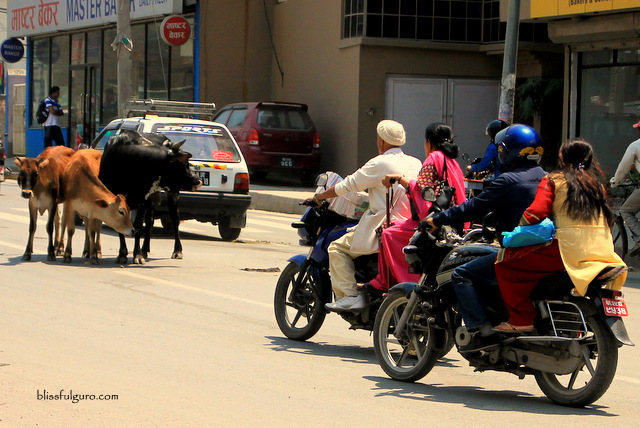 |
| Kings of the road |
We finally reached the temple in about an hour. We slumped into a park
near the temple and regrouped. A troop of monkeys surrounded us and although
they looked so cute I didn’t dare to make friends with them. I just don’t have
that power to connect with animals. But they posed no harm and were seemed to
be having some lull time around.
We were exhausted from walking. I was so tired that I all I wanna do is
sit around and forget about the temple (and the stroll around it). But then, I pushed
myself to go on and just forget about my exhaustion. So we moved forward.
Looking back, the decision to walk instead of riding a bus or cab was the
best option for us (that saved our dinner right there), it was actually
rewarding especially after catching a glimpse of the Nepalese way of life. I
was trying to compare it to the Philippines and in some way there are
similarities. The simplicity of their life and the tenacity to move forward in
spite of insufficiencies are some of which. I wasn’t frightened during the
course for everyone has a ready smile when we greet them, Namaste!
Pashupatinath Home for the Elderly
Clueless on where to go, we headed straight to what seemed to be the way
going to the temple. We then saw the Social Welfare Center’s Home for the Elderly, the only government-sponsored
elderly’s home in Nepal. Established in 1882, this center in Pashupatinath has
a total capacity of 230 homeless Nepalese citizens that are 65 years of age and
above.
We went inside and greeted everyone our standard Namaste greetings and they graciously welcomed us inside. At that
moment we felt like we’re transported back in time. The stillness of the place
is the total opposite to the fast-paced life outside. It seemed like everything
resisted the change that’s happening from the other side of the thick walls.
 |
| It was serene and really quiet |
A perfect square courtyard was surrounded with elderly quarters. Several
elderly women basking under the afternoon sun can be seen on a shrine platform
in the center. Others were hemming some clothes and having their naptime. While
some were just, well, lounging. They seemed to be quiet and didn’t speak that
much with their chummies. The time stood still in this place.
Some might feel sad about this fact but I felt good after seeing the
looks of contentment on their faces. And why not, they are at the foot of the
most sacred Hindu shrine in Nepal and just near the holy Bagmati River where the
ashes of the cremated dead bodies are thrown away to flow downstream,
eventually, into the sacred Ganges River (Hindus believe that to be
cremated after death releases them from the repeated birth and death cycle).
Dhanybad (Thank you), I gladly expressed my gratitude to
everyone as we leave them behind. They may not be the
cheery-all-smiles-hi-everyone type of persons but I appreciated the little
gestures they made to welcome us in their dwelling place.
Pashupatinath Temple
Moving on, we went further to Pashupatinath Temple and were confronted,
again, with the dreaded entrance fee. We needed to shell out 1,000 Rupees (US$
10) each to get a glimpse of Nepal’s most sacred Hindu shrine and the seat of
Lord Pashupatinath, the national deity; decisions, decisions.
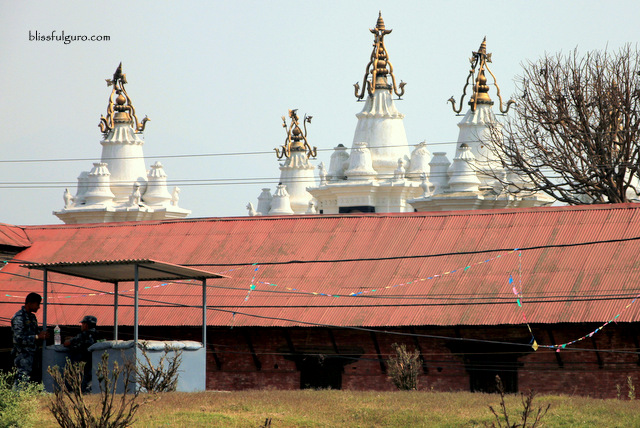 |
| Guarded |
Admitting the fact that we didn’t have enough money to pay for the
entrance fee, we just sat under a tree and accepted the defeat. As we were
about to leave, a Nepalese guy went to us and asked, What country are you from, and then a glimmer of hope followed.
It may seem that this guy is in for some scam or something but his
friendly nature was legit. He was asking if we’ve already been inside the
temple and we explained to him our situation. He quite understood our dilemma
and he offered some ways for us to get inside the temple, he was asking no
money from us, by the way. He offered to get us in after the open hours, which
was two hours ahead, we politely declined the idea. He also offered to help us
ask a discount from the tourism center, again, we declined. He looked really
upset on us not getting inside so he pointed a back entrance that is usually open
for locals. We thanked him and went ahead to that direction with the intentions
of just checking out the temple from the hill.
 |
| The view of the temple from the hill |
We did get to the top of the hill and saw the temple from that standpoint.
We went further and saw a path leading inside. And then we got in. It was a
busy day and different ceremonies were happening simultaneously. Cremations are
also being done on the Bagmati River. All of that and more are happening in
this most sacred Hindu shrine in Nepal, we didn’t get to see any of those for
the temples are strictly for Hindus only.
We headed to the exit gates and went to the bus station to catch a ride
back to Asan area (15 Rupees/US$0.15 each).
The bus ride was so convenient that in no time we were back again at
downtown Kathmandu. Our day has been rewarding in spite of the challenges and feats
of going around the temples and shrines. I am not proud of sneaking inside
these holy places and will not justify it by constantly telling everyone that
we don’t have the money to spare. But it is the fact and we resigned every time
we’re confronted with that situation.
The essence of this temple tales is the people of Kathmandu. Our
experiences wouldn’t be the same without the kindness and help they extended to
us. I also love the life and meaning they give to the temples and shrines. They
accentuate the existence of these structures and give this vibrant soul that
you’ll never feel if those places are empty. Kathmandu is beautiful, and the
people, they’re just so lovely.

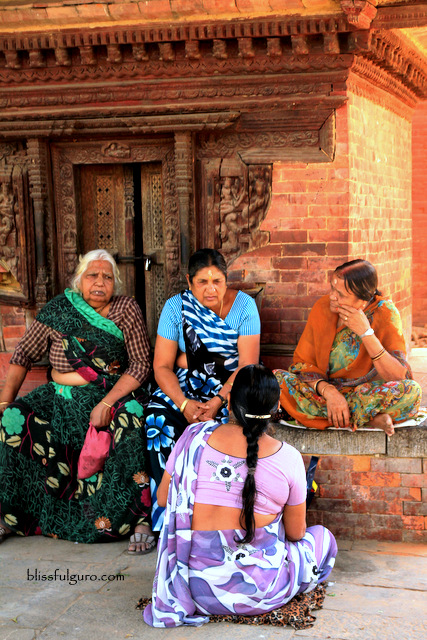
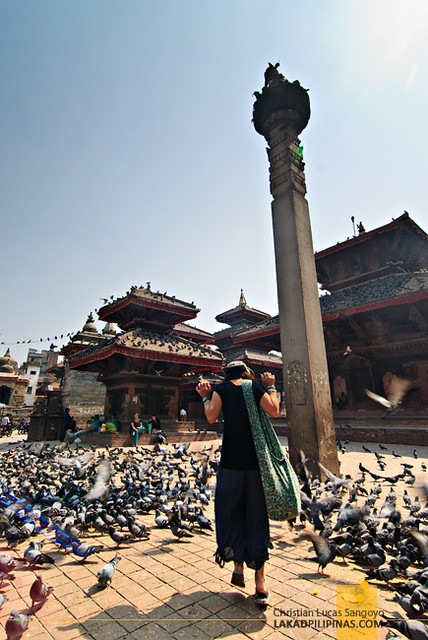
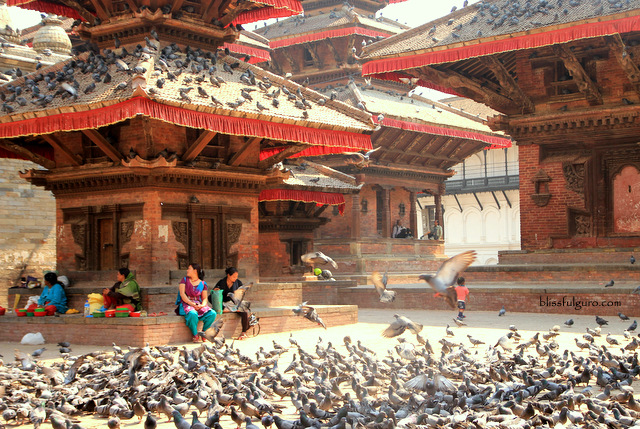
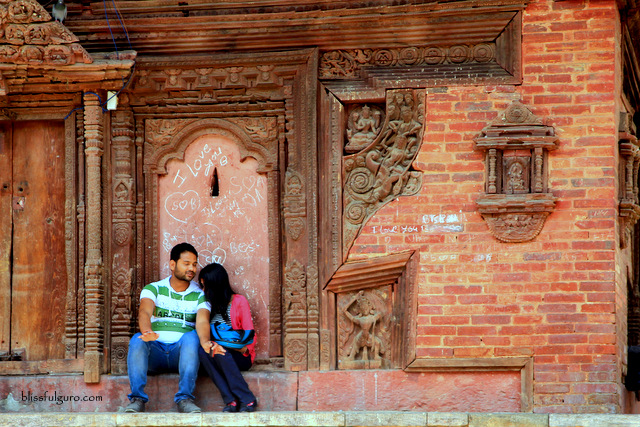
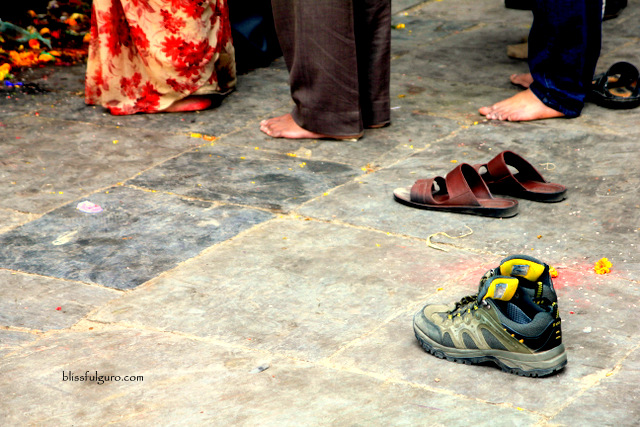
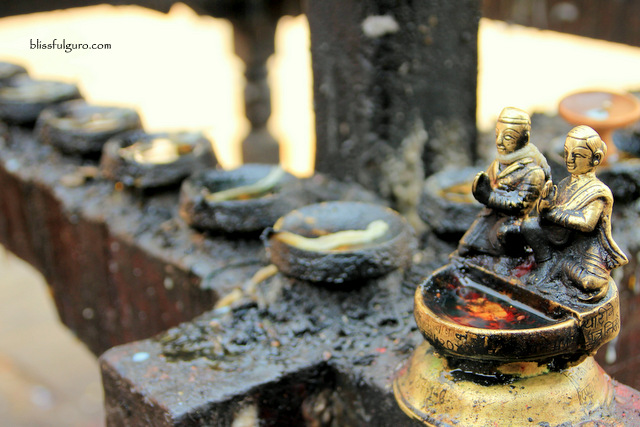
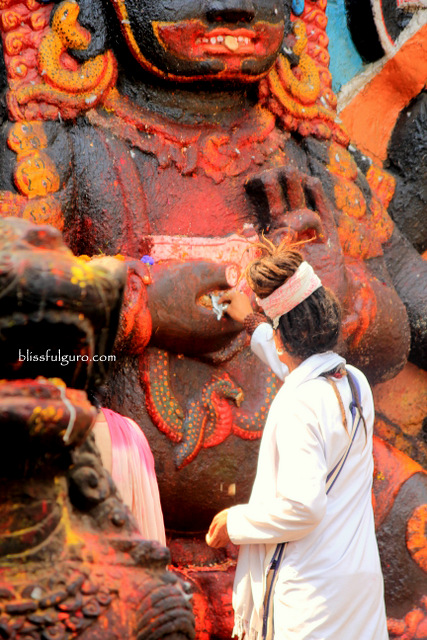
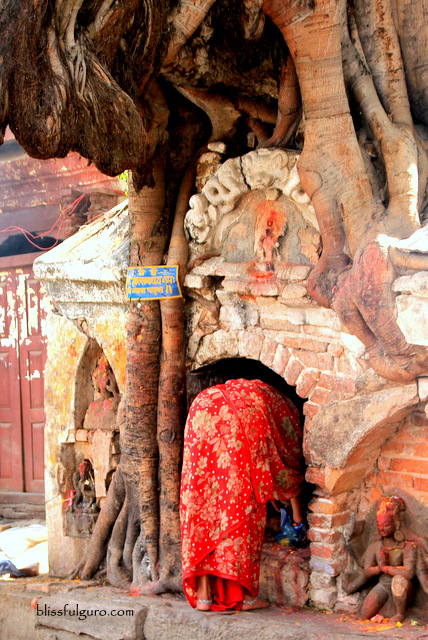
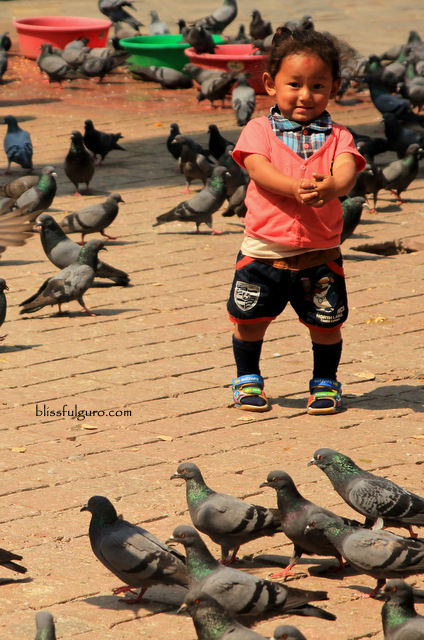
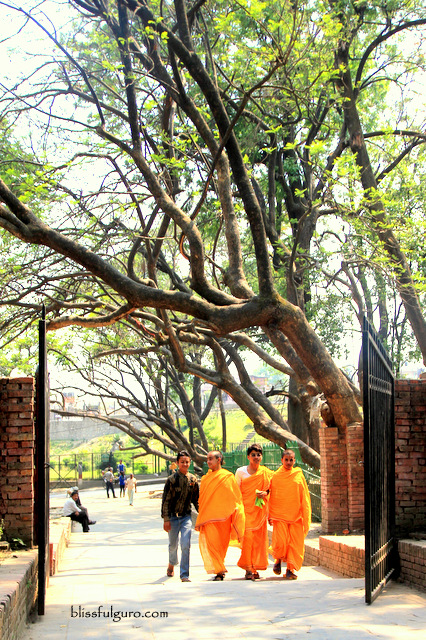
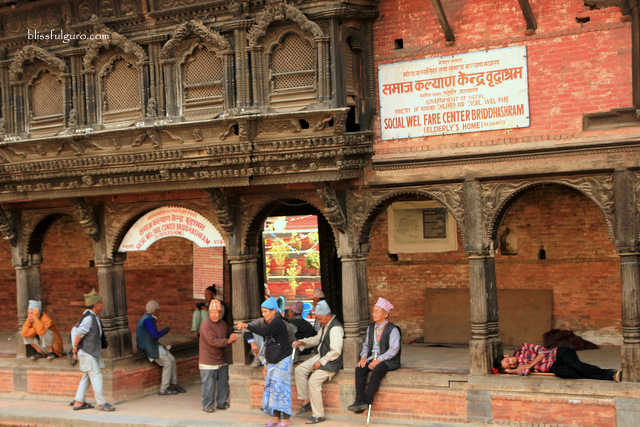
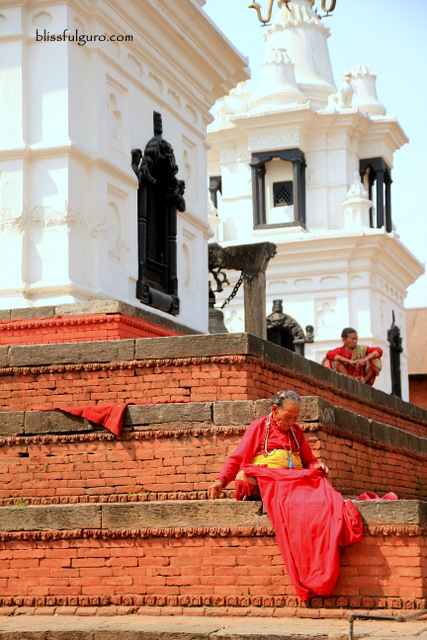
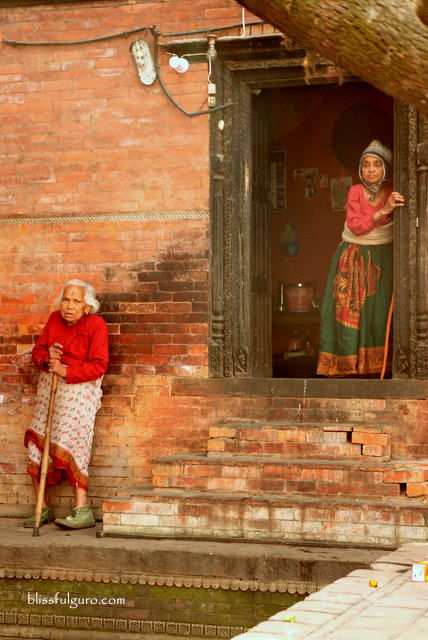

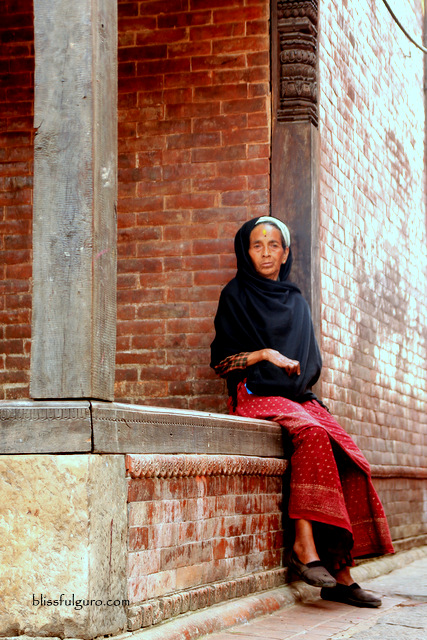

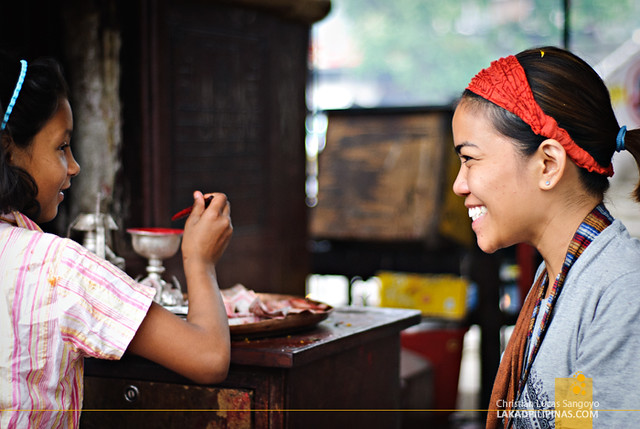
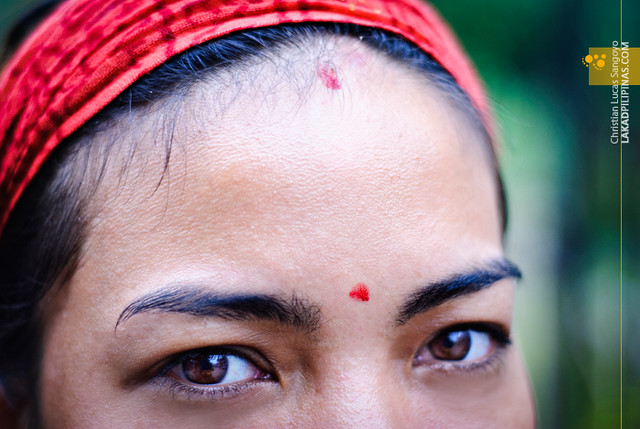













Galing! Pwede ba ko magtanong ng mga detalye ng pagpunta sa Nepal? Like costs, visa application procedures, etc?
ReplyDeleteOf course Jay! :)
DeleteGanda ng mga pictures. Anong camera po gamit nyo? Thanks.
ReplyDeleteThanks Candy! Canon 550D yung camera ko :)
Delete